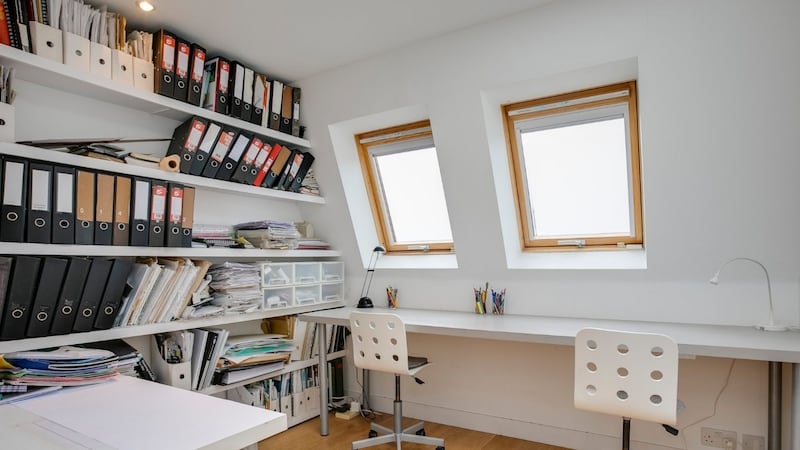Working from home has become one of those "new normal" things for hundreds of thousands of Irish people since the latest round of Covid-19 restrictions came into effect. Many of them seem to have adapted quite quickly with 59 per cent of people surveyed by the National Recruitment Federation this week declaring themselves happier working remotely than in the office and 68 per cent saying they would be happy to work remotely with just occasional office meetings in future.
But there is nothing normal about working from a corner of a messy kitchen table while trying to protect your laptop from egg yolk and coffee spillages. And the sight of cats, dogs and kids invading the background on your daily Zoom conference call ceases to be cute after a while.
Like with bedsits, co-living hubs and family holidays in overcrowded mobile homes, you can tolerate just about anything for short periods, and even convince yourself they are fun.
But what happens when the short-term turns into the long-term? As more and more employers recognise the business benefits of home working, more permanent workspace solutions will be required by their workers.

‘No continuity’
Architect Madeleine Moore has been working from her home in Harold's Cross for the past 13 years and doesn't agree with working at the kitchen table. "This must be the worst place to work. There is no continuity. If you have a family you've got to clear it three times a day at least."
Moore has five personal workspaces in her home at 94 Harold's Cross Cottages, which is currently on the market as the family plans to build a new home in the area.
“We have a 4-metre-long oak counter top downstairs where two people can work as and when they need to,” she says. “And we have four different workspaces upstairs where I can do model making, hand drawing, use the Autocad workstation and my laptop. The key thing long term is to have built-in storage for all the bits and pieces you need for work. A lot may have gone digital, but you still need paper and equipment.”
Standard feature
She says workspaces, either in a separate room or as part of a larger room, will be a standard feature of homes in future.
“When I design houses for clients, I always include space for home working, whether that’s for kids doing homework, or a desk for an adult to do the family admin and space to house a printer – this was before the current working from home arrangements. All new homes should be designed with home-working spaces.”
Deirdre O’Gara of DNG estate agents, who is looking after the sale of Moore’s cottage, agrees. “This is something people are going to think about a lot more and I suspect houses with home-working spaces will be more attractive in future. A lot of new builds are including small home offices now.”
According to Alan Burns of Bright Design Architects, distractions are the main enemy of productivity for home workers. "Having a separate space is always preferred but not always possible," he says. "A degree of separation will help to provide acoustic separation from the cacophony of family life. This can take the form of a retreat space such as a converted attic, a dedicated study or a garden room."
His firm offers ingenious solutions for those living in smaller houses or apartments where this is not possible.
“Spaces have to become multifunctional,” he says. “Often the potential of a nook, a fireside alcove or niche can be exploited. The fundamental point is that it can be hidden away after five o’clock so that work life is kept ‘out of sight, out of mind’ of home life. A sliding door or folding wall manages this feat very discreetly but remember that it must be a good bit deeper than the desk if you want to hide the chair as well. Another space-saving solution is a foldover table top with built-in shallow storage. Doubling up on use of spaces and functions is key – tiny homes can often generate big ideas.”
Psychology
But successful home working is more than just about having the space and the right equipment. Psychology comes into it as well. "People tend to make very generalised statements, but we are all individuals," says organisational psychologist Kathleen Halligan. "Personalities can determine whether we like to work from home and find it easy or not."
Establishing a routine is key, she adds.
“When we hear people talking about adapting to home working at the moment a lot of them are saying it got better when they introduced a routine. The brain loves routine. Having more predictability means less oxygen is used to figure out what to do next. That can be a reason why people enjoy getting up to go to work in the mornings. It’s part of their routine even though it may involve a long commute.”
That routine should include clearly defined barriers between work and personal lives, according to Burns.
“At the very least working from home offers an opportunity to eliminate the twice-daily commute and use that extra time wisely for a better work-life balance. However, that work and home life separation needs to be maintained as much as possible otherwise the benefits of one can get quickly eroded by the other.”
If you are interested in exploring the dedicated workspace possibilities in your home, while giving to charity, you can avail of a 45-minute remote-design consultation from Bright Design Architects in return for a donation to Pieta Darkness Into Light – Cabinteely. Just send an email to info@bda.ie to set it up.











